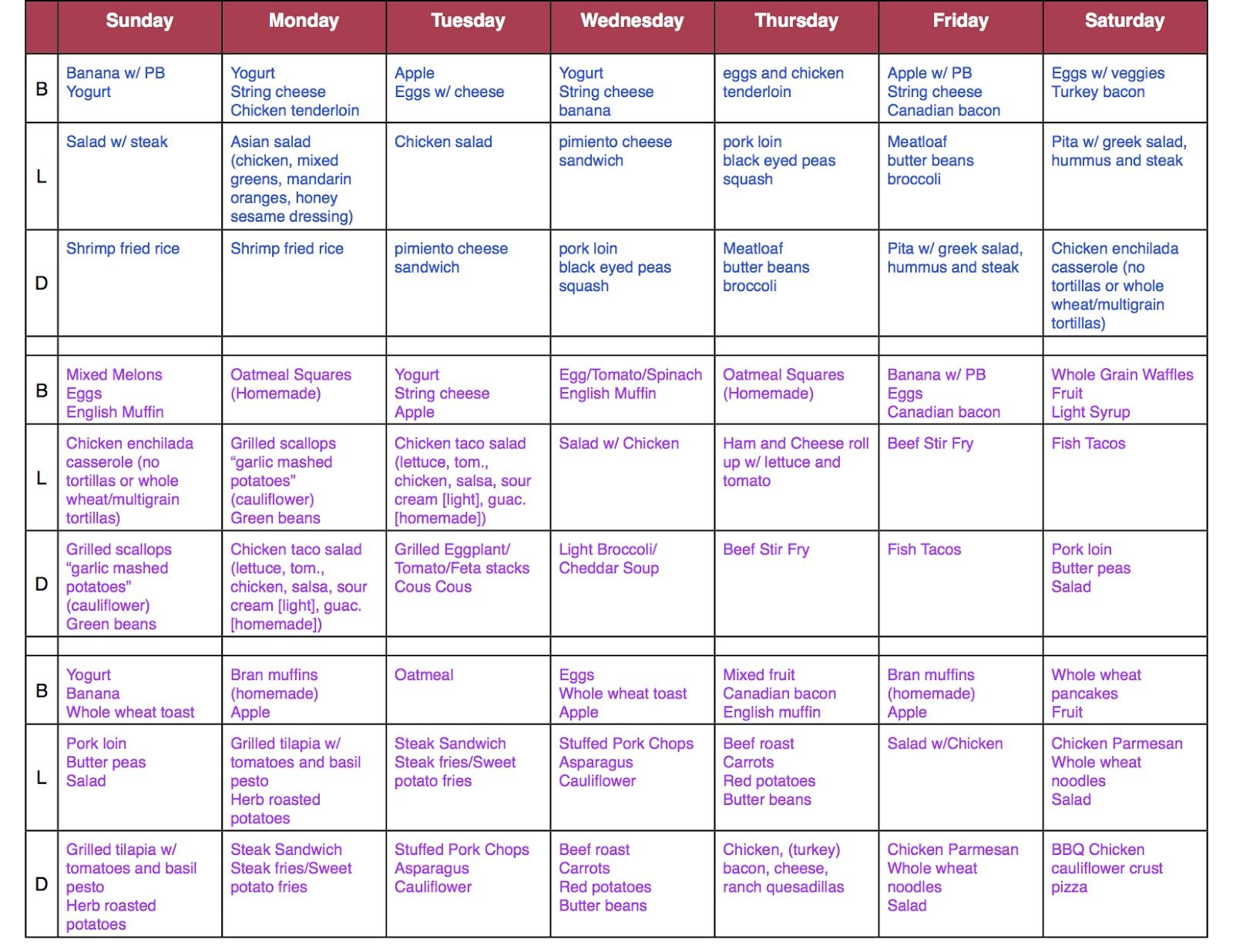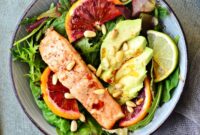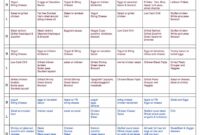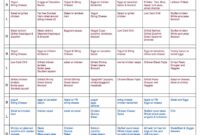South Beach Diet List: Embark on a culinary journey with this comprehensive guide to the South Beach Diet. We’ll explore the diet’s three phases, detailing the allowed and restricted foods in each, providing sample meal plans, and addressing common concerns. This detailed breakdown will empower you to make informed choices and achieve your health goals.
This guide offers a structured approach to understanding the South Beach Diet, moving from the foundational principles and phase-specific food lists to practical meal planning and addressing potential challenges. We’ll delve into the benefits and risks, offer modifications for various dietary needs, and provide answers to frequently asked questions, ensuring a complete understanding of this popular diet plan.
Understanding the South Beach Diet
The South Beach Diet is a popular weight-loss plan that emphasizes a balanced approach to eating, focusing on healthy fats and lean proteins while limiting refined carbohydrates and sugary foods. Unlike many restrictive diets, it aims for sustainable weight management through lifestyle changes rather than rapid, unsustainable weight loss.
Core Principles of the South Beach Diet
The South Beach Diet’s core principle revolves around controlling blood sugar levels through careful carbohydrate selection. It prioritizes “good” carbohydrates, such as whole grains and fruits, while restricting “bad” carbohydrates like refined sugars, white bread, and processed foods. This approach aims to minimize insulin spikes and promote steady energy levels, reducing cravings and promoting satiety. The diet also encourages the consumption of healthy fats, lean protein sources, and plenty of vegetables. This balanced macronutrient approach is designed to support overall health and well-being beyond just weight loss.
Phases of the South Beach Diet
The South Beach Diet is structured into three phases: Phase 1, Phase 2, and Phase 3. Each phase progressively introduces more food choices, allowing for greater flexibility as weight loss progresses and healthy habits are established.
Phase 1: The Initial Phase
This phase is the most restrictive, lasting approximately two weeks. The goal is to kick-start weight loss by significantly reducing refined carbohydrates and unhealthy fats. This initial restriction helps to control blood sugar levels and reduce cravings.
Phase 2: The Ongoing Weight Loss Phase
Once initial weight loss is achieved, the diet transitions to Phase 2. This phase introduces more carbohydrate choices, such as whole grains and certain fruits, while maintaining restrictions on unhealthy carbohydrates and fats. This phase continues until the desired weight is reached.
Phase 3: The Lifetime Maintenance Phase
Phase 3 focuses on long-term weight maintenance. It emphasizes continued healthy eating habits and incorporates a wider variety of foods, allowing for greater flexibility while preventing weight regain. This phase emphasizes mindful eating and regular physical activity to sustain the weight loss achieved in the previous phases.
Comparison to Other Popular Diets
The South Beach Diet differs from other popular diets in its approach to carbohydrates. Unlike ketogenic diets that severely restrict carbohydrates, the South Beach Diet focuses on selecting healthy carbohydrates while limiting unhealthy ones. Compared to low-fat diets, it emphasizes the importance of healthy fats in promoting satiety and overall health. It’s less restrictive than many other popular diets, allowing for a greater variety of foods over time, which can contribute to better long-term adherence.
Allowed and Restricted Foods in Each Phase
| Phase | Allowed Foods | Restricted Foods | Notes |
|---|---|---|---|
| Phase 1 | Lean proteins (fish, poultry, beans), non-starchy vegetables, healthy fats (olive oil, avocados), nuts (in moderation) | Sugary drinks, white bread, pasta, pastries, most fruits, processed foods, high-fat meats | Focus on controlling blood sugar and reducing cravings. |
| Phase 2 | All foods allowed in Phase 1, plus whole grains, some fruits (berries, apples), legumes | Most processed foods, sugary drinks, high-fat meats | Gradually increase carbohydrate intake while maintaining healthy choices. |
| Phase 3 | Most foods in moderation, including occasional treats | Highly processed foods, excessive amounts of unhealthy fats and sugars | Focus on long-term maintenance through balanced eating and regular exercise. |
Food List Breakdown: Phase 1
Phase 1 of the South Beach Diet is a crucial introductory phase designed to jumpstart weight loss and retrain your palate to favor healthier food choices. This initial phase focuses on eliminating simple carbohydrates and refined sugars, which are often the primary culprits behind weight gain and metabolic imbalances. By restricting these foods, you’ll experience a reduction in blood sugar spikes and cravings, paving the way for sustainable weight management. The following list details the foods permitted during this phase, categorized for clarity and ease of understanding.
Allowed Foods in Phase 1: Vegetables
Vegetables are a cornerstone of the South Beach Diet, providing essential vitamins, minerals, and fiber while remaining low in carbohydrates. These nutrients are vital for overall health and contribute to feelings of fullness, aiding in weight loss. Aim for a variety of colorful vegetables to maximize your nutritional intake.
- Leafy greens (spinach, kale, lettuce)
- Cruciferous vegetables (broccoli, cauliflower, Brussels sprouts)
- Other vegetables (asparagus, peppers, zucchini, eggplant, mushrooms, onions, garlic)
Allowed Foods in Phase 1: Proteins
Protein is essential for building and repairing tissues, maintaining muscle mass, and keeping you feeling satisfied. Prioritizing lean protein sources helps control hunger and supports a healthy metabolism.
- Lean meats (chicken breast, turkey breast, fish, lean beef)
- Eggs
- Legumes (in moderation, such as lentils and chickpeas – check carbohydrate content)
- Tofu and tempeh (soy-based protein sources)
Allowed Foods in Phase 1: Healthy Fats
Healthy fats are vital for hormone production, brain function, and nutrient absorption. Choosing the right fats is crucial for overall well-being and can contribute to satiety.
- Olive oil
- Avocado
- Nuts (almonds, walnuts, pecans – in moderation)
- Seeds (chia seeds, flax seeds)
- Fatty fish (salmon, tuna, mackerel)
Allowed Foods in Phase 1: Other
Beyond the main categories, several other foods are permissible in Phase 1. These additions provide variety and contribute to a well-rounded diet.
- Unsweetened tea and coffee
- Water
- Plain yogurt (unsweetened and low-fat)
Sample Phase 1 Meal Plan
This sample meal plan demonstrates how to incorporate the allowed foods into a balanced and satisfying daily diet. Remember to adjust portion sizes to meet your individual caloric needs.
Breakfast: Scrambled eggs with spinach and a small avocado.
Lunch: Grilled chicken salad with mixed greens, peppers, and a light olive oil dressing.
Dinner: Baked salmon with roasted asparagus and a side of steamed broccoli.
Food List Breakdown: Phase 2
Phase 2 of the South Beach Diet marks a significant transition, gradually reintroducing certain carbohydrates while maintaining the focus on healthy fats and lean proteins established in Phase 1. This phase aims to achieve sustainable weight loss and improve overall health by teaching you how to incorporate more complex carbohydrates into your diet without derailing your progress. The expansion of food choices allows for greater meal variety and helps prevent dietary boredom, a common challenge in restrictive diets.
Allowed Foods in Phase 2
The key difference between Phase 1 and Phase 2 lies in the addition of certain healthy carbohydrates. While highly processed carbohydrates, sugary drinks, and unhealthy fats remain restricted, Phase 2 introduces a wider selection of fruits, vegetables, and whole grains. This gradual reintroduction helps your body adapt and prevents potential negative consequences associated with a sudden influx of carbohydrates.
- Fruits: Berries (strawberries, blueberries, raspberries), apples, pears, oranges (in moderation). The focus remains on lower-glycemic fruits that release sugar more slowly into the bloodstream.
- Vegetables: All vegetables are generally permitted, including starchy vegetables like potatoes (in moderation) and corn (in moderation).
- Whole Grains: Whole-wheat bread (in moderation), brown rice, quinoa, and oats are now allowed. These provide valuable fiber and nutrients.
- Legumes: Lentils, chickpeas, and black beans, excellent sources of protein and fiber, can be incorporated into meals.
- Healthy Fats: Continue to prioritize healthy fats such as avocados, nuts, seeds, and olive oil.
- Lean Protein: Maintain your intake of lean protein sources like fish, poultry, and beans.
Transitioning from Phase 1 to Phase 2: Potential Challenges
Moving from the restrictive Phase 1 to the more lenient Phase 2 can present some challenges. The primary challenge lies in mindful portion control. The increased availability of carbohydrates can lead to overconsumption if not carefully managed. Another potential challenge is identifying truly healthy carbohydrate sources and avoiding processed foods masquerading as healthy options. Careful meal planning and label reading are crucial during this transition. Some individuals may also experience temporary bloating or digestive discomfort as their bodies adjust to the increased fiber intake.
Sample Phase 2 Meal Plan
This sample meal plan demonstrates how to incorporate the expanded food choices of Phase 2 while maintaining a healthy balance of nutrients. Remember to adjust portion sizes based on your individual caloric needs and activity level.
- Monday:
- Breakfast: Oatmeal with berries and nuts
- Lunch: Chicken salad sandwich on whole-wheat bread with lettuce and tomato
- Dinner: Baked salmon with roasted vegetables (broccoli, carrots, sweet potatoes)
- Tuesday:
- Breakfast: Scrambled eggs with spinach and whole-wheat toast
- Lunch: Lentil soup with a side salad
- Dinner: Chicken stir-fry with brown rice and a variety of vegetables
- Wednesday:
- Breakfast: Greek yogurt with fruit and a sprinkle of granola
- Lunch: Turkey breast wrap with hummus and vegetables
- Dinner: Quinoa salad with chickpeas, cucumber, tomatoes, and a lemon vinaigrette
- Thursday:
- Breakfast: Smoothie with berries, spinach, and protein powder
- Lunch: Leftover quinoa salad
- Dinner: Lean ground beef and vegetable skillet with a small baked potato
- Friday:
- Breakfast: Whole-wheat pancakes with berries and a small amount of maple syrup
- Lunch: Tuna salad with avocado on whole-wheat crackers
- Dinner: Grilled chicken breast with roasted asparagus and a small sweet potato
- Saturday:
- Breakfast: Omelet with mushrooms, onions, and peppers
- Lunch: Leftover grilled chicken and vegetables
- Dinner: Chicken and vegetable skewers with brown rice
- Sunday:
- Breakfast: Fruit salad with a dollop of Greek yogurt
- Lunch: Large salad with grilled chicken or fish
- Dinner: Baked chicken breast with steamed broccoli and a small portion of mashed sweet potatoes
Food List Breakdown: Phase 3 (Maintenance)
Phase 3 of the South Beach Diet marks the transition from active weight loss to long-term weight management. This phase isn’t about strict restrictions, but rather about establishing sustainable healthy eating habits to maintain your weight loss and overall well-being. It emphasizes incorporating a wider variety of foods while remaining mindful of portion sizes and healthy choices.
Principles of the Maintenance Phase
The core principle of the South Beach Diet’s maintenance phase is to gradually reintroduce more carbohydrates while carefully monitoring your weight and energy levels. This isn’t a free-for-all; it’s a balanced approach that prioritizes whole, unprocessed foods and limits processed foods, sugary drinks, and unhealthy fats. The goal is to find a personalized eating plan that allows you to enjoy a variety of foods without compromising your weight loss progress. Regular monitoring of your weight and adjusting your intake accordingly is crucial during this phase. Successful maintenance hinges on mindful eating and understanding your body’s cues regarding hunger and satiety.
Long-Term Dietary Guidelines for Sustaining Weight Loss
Sustaining weight loss requires a long-term commitment to healthy eating and lifestyle choices. This involves focusing on nutrient-dense foods, such as fruits, vegetables, lean proteins, and whole grains. Prioritizing fiber-rich foods helps promote satiety, preventing overeating and cravings. Regular physical activity remains vital, contributing to both weight management and overall health. Planning meals and snacks in advance can prevent impulsive, unhealthy choices. Keeping a food diary can help monitor your intake and identify areas for improvement. The emphasis is on making gradual, sustainable changes, rather than drastic, unsustainable diets.
Strategies for Preventing Weight Regain
Weight regain is a common challenge after weight loss. Several strategies can help prevent it. Regular weigh-ins help detect early signs of weight gain. Staying active through regular exercise, even moderate activity like walking, is essential. Mindful eating practices, such as paying attention to hunger and fullness cues, prevent overconsumption. Stress management techniques, such as yoga or meditation, are crucial as stress can lead to emotional eating. Seeking support from friends, family, or a support group can provide accountability and encouragement. Regularly reviewing and adjusting your meal plan to suit your needs and preferences is important to avoid monotony and maintain adherence.
Incorporating a Variety of Foods While Maintaining a Healthy Lifestyle
The maintenance phase allows for a wider variety of foods. This doesn’t mean reverting to old, unhealthy habits. Instead, it involves strategically adding more carbohydrate-rich foods, like whole grains, fruits, and vegetables, while still prioritizing lean proteins and healthy fats. For example, you could incorporate a wider range of fruits and vegetables, experimenting with different cooking methods and recipes. You could also include more whole grains, such as brown rice or quinoa, in your meals. The key is to make informed choices and to focus on portion control. Remember that even healthy foods can contribute to weight gain if consumed in excess. Finding a balance and enjoying a variety of foods without overindulging is the key to successful long-term weight management.
Recipes and Meal Planning
The South Beach Diet’s success hinges on adhering to its principles while enjoying delicious and satisfying meals. Careful meal planning, incorporating a variety of approved foods, is key to long-term adherence and achieving your weight loss goals. This section provides sample recipes and meal plans to guide you through each phase.
Phase 1 Recipes and Balanced Plate
Phase 1 emphasizes lean protein, healthy fats, and non-starchy vegetables. Recipes should be simple, focusing on the natural flavors of the ingredients.
- Grilled Salmon with Asparagus: Season salmon fillets with herbs and lemon juice, grill until cooked through. Steam or roast asparagus spears until tender-crisp. This provides a high-protein, healthy-fat meal with plenty of fiber.
- Chicken and Vegetable Stir-fry: Stir-fry diced chicken breast with broccoli florets, bell peppers, and onions in a light olive oil and soy sauce based sauce. This is a quick and easy meal, packed with nutrients.
- Tuna Salad Lettuce Wraps: Mix canned tuna (in water) with chopped celery, red onion, and a light mayonnaise substitute (such as avocado mayo). Serve in crisp lettuce cups. This is a light and refreshing option.
A balanced Phase 1 plate would consist of approximately 50% non-starchy vegetables (e.g., broccoli, spinach, asparagus), 25% lean protein (e.g., grilled chicken breast, fish, tofu), and 25% healthy fats (e.g., olive oil, avocado, nuts).
Phase 2 Recipes and Balanced Plate
Phase 2 introduces some healthy carbohydrates back into the diet, focusing on whole grains and legumes.
- Lentil Soup: A hearty and nutritious soup made with lentils, carrots, celery, and vegetable broth. This adds fiber and complex carbohydrates.
- Quinoa Salad with Grilled Chicken: Combine cooked quinoa with grilled chicken, chopped cucumber, tomatoes, and a lemon vinaigrette. This provides a balanced meal with protein, fiber, and healthy fats.
- Whole Wheat Pasta with Marinara Sauce and Lean Ground Turkey: Use whole wheat pasta and lean ground turkey to create a satisfying and nutritious pasta dish.
A balanced Phase 2 plate would include approximately 40% non-starchy vegetables, 30% lean protein, 20% healthy carbohydrates (e.g., quinoa, whole wheat pasta, brown rice), and 10% healthy fats.
Phase 3 (Maintenance) Recipes and Balanced Plate
Phase 3 focuses on maintaining a healthy lifestyle and weight. A wider variety of foods is permitted, but portion control remains important.
- Chicken and Brown Rice Bowl: Combine grilled chicken breast, brown rice, mixed vegetables, and a light teriyaki sauce. This is a balanced and flavorful meal.
- Sweet Potato and Black Bean Burrito Bowl: A flavorful bowl with roasted sweet potato, black beans, salsa, avocado, and a dollop of plain Greek yogurt.
- Salmon with Roasted Vegetables and Wild Rice: A delicious and healthy meal packed with nutrients.
A balanced Phase 3 plate would comprise approximately 35% non-starchy vegetables, 30% lean protein, 25% healthy carbohydrates, and 10% healthy fats. Portion sizes are adjusted to maintain a healthy calorie intake.
7-Day Sample Meal Plan
This sample meal plan incorporates recipes and food choices from all three phases, demonstrating the variety possible within the South Beach Diet. Remember to adjust portion sizes to your individual needs and calorie goals.
- Day 1: Grilled Salmon with Asparagus, mixed green salad with olive oil and lemon juice.
- Day 2: Chicken and Vegetable Stir-fry, small portion of brown rice.
- Day 3: Lentil Soup, whole-wheat bread (small slice).
- Day 4: Quinoa Salad with Grilled Chicken.
- Day 5: Whole Wheat Pasta with Marinara Sauce and Lean Ground Turkey.
- Day 6: Chicken and Brown Rice Bowl.
- Day 7: Sweet Potato and Black Bean Burrito Bowl.
Potential Benefits and Risks
The South Beach Diet, like any other weight-loss plan, presents a spectrum of potential benefits and drawbacks. Understanding both sides is crucial for making an informed decision about whether it’s the right approach for individual health goals. While it can be effective for short-term weight loss, its long-term sustainability and overall impact on health require careful consideration.
The South Beach Diet’s structure, focusing on controlled carbohydrate intake and prioritizing healthy fats and lean proteins, can lead to several positive outcomes. However, potential negative consequences, particularly if not followed correctly or if individual health factors are not considered, should also be carefully weighed.
Health Benefits of the South Beach Diet
The South Beach Diet’s emphasis on nutrient-rich foods can contribute to various health improvements. By restricting processed carbohydrates and refined sugars, it can lead to improved blood sugar control, particularly beneficial for individuals with pre-diabetes or type 2 diabetes. The diet’s focus on lean protein and healthy fats can also contribute to satiety, helping manage hunger and cravings, thus aiding in weight management. Furthermore, the increased intake of fruits, vegetables, and whole grains provides essential vitamins, minerals, and fiber, promoting overall health and well-being. Studies have shown that individuals following the South Beach Diet often experience reductions in LDL (“bad”) cholesterol and improvements in blood pressure.
Risks and Drawbacks of the South Beach Diet
While offering potential benefits, the South Beach Diet also presents certain risks. The restrictive nature of the initial phases can lead to nutrient deficiencies if not carefully planned. The exclusion of entire food groups, like many fruits and starchy vegetables in the early phases, can be difficult to maintain long-term and may lead to feelings of deprivation. Furthermore, the rapid weight loss experienced in the initial phase might not be sustainable, potentially resulting in weight regain once the diet is discontinued. Some individuals might experience side effects like headaches, fatigue, or constipation, especially during the initial restrictive phase. The lack of flexibility in the initial phases may also make it difficult to adapt the diet to social situations or travel.
Short-Term and Long-Term Effects
Short-term effects often include noticeable weight loss and improvements in blood sugar control and lipid profiles. However, the long-term effects depend largely on the individual’s ability to maintain the dietary changes beyond the initial phases. If the diet is abandoned, weight regain is likely. Successful long-term adherence often requires a significant lifestyle shift towards healthier eating habits and regular physical activity. Studies on the long-term success rates of the South Beach Diet are limited, highlighting the need for sustained commitment and potentially ongoing support to achieve lasting results.
Summary of Benefits and Risks
| Benefits | Risks |
|---|---|
| Weight loss | Nutrient deficiencies |
| Improved blood sugar control | Headaches, fatigue, constipation |
| Improved lipid profile (cholesterol levels) | Difficulty adhering long-term |
| Increased satiety | Potential for weight regain |
| Increased intake of fruits, vegetables, and whole grains | Restrictive nature in initial phases |
Alternatives and Modifications
The South Beach Diet, while effective for many, requires adjustments for individuals with specific dietary needs or preferences. Adapting the plan to accommodate vegetarianism, veganism, or allergies necessitates careful planning and substitution of foods to maintain the diet’s core principles of controlled carbohydrate intake and emphasis on healthy fats and lean protein. This section explores modifications to make the South Beach Diet accessible and suitable for a wider range of individuals.
Vegetarian and Vegan Adaptations
The South Beach Diet’s emphasis on lean protein might initially seem challenging for vegetarians and vegans. However, plant-based protein sources can easily replace animal products. Legumes such as lentils, chickpeas, and beans are excellent sources of protein and fiber, fitting well within the diet’s framework. Tofu, tempeh, and seitan provide further protein options. Furthermore, nuts, seeds, and quinoa are also valuable additions to a vegetarian or vegan South Beach Diet plan. Careful attention should be paid to portion sizes and the glycemic index of chosen carbohydrates, ensuring adherence to the phased approach of the diet. For instance, while sweet potatoes are permitted in later phases, they should be consumed in moderation.
Accommodating Dietary Restrictions and Allergies
Managing allergies or intolerances within the South Beach Diet requires mindful food selection and substitution. Individuals with gluten intolerance or celiac disease should opt for gluten-free grains like quinoa or brown rice (in later phases). Dairy allergies can be managed by substituting dairy products with plant-based alternatives like almond milk, soy milk, or coconut milk. Those with nut allergies need to carefully avoid nuts and nut-based products, replacing them with sunflower seeds or pumpkin seeds as a source of healthy fats. Always check food labels carefully for potential allergens and consult with a registered dietitian or allergist to create a safe and effective personalized plan.
Comparison with Other Low-Carbohydrate Diets
The South Beach Diet distinguishes itself from other low-carbohydrate diets through its phased approach and focus on healthy fats and lean protein. Unlike some stricter ketogenic diets that severely restrict carbohydrate intake, the South Beach Diet allows for a gradual increase in carbohydrate consumption as the body adapts. This phased approach is intended to be more sustainable and less likely to trigger side effects such as the “keto flu”. Furthermore, unlike some low-carb diets that may emphasize saturated fats, the South Beach Diet prioritizes healthier unsaturated fats from sources like olive oil, avocados, and nuts. The specific permitted foods and the emphasis on whole, unprocessed foods also set it apart from other diets that may allow processed low-carb options. The South Beach Diet’s focus on a balanced nutritional profile makes it a more comprehensive approach to weight management compared to some restrictive low-carbohydrate alternatives.
Summary
Successfully navigating the South Beach Diet requires a commitment to understanding its principles and adapting it to your individual needs. By following the guidelines presented here, focusing on healthy food choices, and incorporating mindful meal planning, you can embark on a journey towards a healthier lifestyle. Remember to consult with a healthcare professional before making significant dietary changes.




